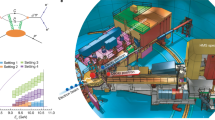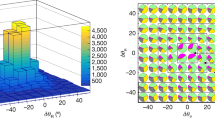Abstract
The fundamental building blocks of the proton—quarks and gluons—have been known for decades. However, we still have an incomplete theoretical and experimental understanding of how these particles and their dynamics give rise to the quantum bound state of the proton and its physical properties, such as its spin1. The two up quarks and the single down quark that comprise the proton in the simplest picture account only for a few per cent of the proton mass, the bulk of which is in the form of quark kinetic and potential energy and gluon energy from the strong force2. An essential feature of this force, as described by quantum chromodynamics, is its ability to create matter–antimatter quark pairs inside the proton that exist only for a very short time. Their fleeting existence makes the antimatter quarks within protons difficult to study, but their existence is discernible in reactions in which a matter–antimatter quark pair annihilates. In this picture of quark–antiquark creation by the strong force, the probability distributions as a function of momentum for the presence of up and down antimatter quarks should be nearly identical, given that their masses are very similar and small compared to the mass of the proton3. Here we provide evidence from muon pair production measurements that these distributions are considerably different, with more abundant down antimatter quarks than up antimatter quarks over a wide range of momenta. These results are expected to revive interest in several proposed mechanisms for the origin of this antimatter asymmetry in the proton that had been disfavoured by previous results4, and point to future measurements that can distinguish between these mechanisms.
This is a preview of subscription content, access via your institution
Access options
Access Nature and 54 other Nature Portfolio journals
Get Nature+, our best-value online-access subscription
$29.99 / 30 days
cancel any time
Subscribe to this journal
Receive 51 print issues and online access
$199.00 per year
only $3.90 per issue
Buy this article
- Purchase on Springer Link
- Instant access to full article PDF
Prices may be subject to local taxes which are calculated during checkout


Similar content being viewed by others
Data availability
Raw data were generated at the Fermi National Accelerator Laboratory. Derived data supporting the findings of this study are available from the corresponding author upon request.
Change history
08 April 2022
A Correction to this paper has been published: https://doi.org/10.1038/s41586-022-04707-z
References
Ji, X., Yuan, F. & Zhao, Y. Proton spin after 30 years: what we know and what we don’t? Nat. Rev. Phys. 3, 27–38 (2021).
Yang, Y.-B. et al. Proton mass decomposition from the QCD energy momentum tensor. Phys. Rev. Lett. 121, 212001 (2018).
Ross, D. & Sachrajda, C. Flavour symmetry breaking in antiquark distributions. Nucl. Phys. B 149, 497–516 (1979).
Towell, R. S. et al. Improved measurement of the \(\bar{d}/\bar{u}\) asymmetry in the nucleon sea. Phys. Rev. D 64, 052002 (2001).
Fermi, E. & Marshall, L. On the interaction between neutrons and electrons. Phys. Rev. 72, 1139–1146 (1947).
Glück, M. & Reya, E. Dynamical determination of parton and gluon distributions in quantum chromodynamics. Nucl. Phys. B 130, 76–92 (1977).
Parisi, G. & Petronzio, R. On the breaking of Bjorken scaling. Phys. Lett. B 62, 331–334 (1976).
Amaudruz, P. et al. Gottfried sum from the ratio \({F}_{2}^{n}/{F}_{2}^{p}\). Phys. Rev. Lett. 66, 2712–2715 (1991).
Arneodo, M. et al. Reevaluation of the Gottfried sum. Phys. Rev. D 50, R1–R3 (1994).
Drell, S. D. & Yan, T.-M. Massive lepton pair production in hadron-hadron collisions at high-energies. Phys. Rev. Lett. 25, 316–320 (1970); erratum 25, 902 (1970).
Baldit, A. et al. Study of the isospin symmetry breaking in the light quark sea of the nucleon from the Drell-Yan process. Phys. Lett. B 332, 244–250 (1994).
Londergan, J. T. & Thomas, A. W. The validity of charge symmetry for parton distributions. Prog. Part. Nucl. Phys. 41, 49–124 (1998).
Kamano, H. & Lee, T.-S. H. Pion-exchange and Fermi-motion effects on the proton-deuteron Drell-Yan process. Phys. Rev. D 86, 094037 (2012).
Ehlers, P. J., Accardi, A., Brady, L. & Melnitchouk, W. Nuclear effects in the proton-deuteron Drell-Yan process. Phys. Rev. D 90, 014010 (2014).
Ackerstaff, K. et al. Flavor asymmetry of the light quark sea from semi-inclusive deep-inelastic scattering. Phys. Rev. Lett. 81, 5519–5523 (1998).
Chang, W.-C. & Peng, J.-C. Flavor structure of the nucleon sea. Prog. Part. Nucl. Phys. 79, 95–135 (2014).
Geesaman, D. F. & Reimer, P. E. The sea of quarks and antiquarks in the nucleon. Rep. Prog. Phys. 82, 046301 (2019).
Field, R. D. & Feynman, R. P. Quark elastic scattering as a source of high transverse momentum mesons. Phys. Rev. D 15, 2590–2616 (1977).
Steffens, F. M. & Thomas, A. W. Flavor asymmetry of the nucleon sea. Phys. Rev. C 55, 900–908 (1997).
Bourrely, C. & Soffer, J. New developments in the statistical approach of parton distributions: tests and predictions up to LHC energies. Nucl. Phys. A 941, 307–334 (2015).
Basso, E., Bourrely, C., Pasechnik, R. & Soffer, J. The Drell-Yan process as a testing ground for parton distributions up to LHC. Nucl. Phys. A 948, 63–77 (2016).
Pobylitsa, P. V., Polyakov, M. V., Goeke, K., Watabe, T. & Weiss, C. Isovector unpolarized quark distribution in the nucleon in the large-Nc limit. Phys. Rev. D 59, 034024 (1999).
Thomas, A. W. A limit on the pionic component of the nucleon through SU(3) flavor breaking in the sea. Phys. Lett. B 126, 97–100 (1983).
Alberg, M. & Miller, G. A. Taming the pion cloud of the nucleon. Phys. Rev. Lett. 108, 172001 (2012).
Alberg, M. & Miller, G. A. Chiral light front perturbation theory and the flavor dependence of the light-quark nucleon sea. Phys. Rev. C 100, 035205 (2019).
Lin, H.-W. et al. Parton distributions and lattice QCD calculations: a community white paper. Prog. Part. Nucl. Phys. 100, 107–160 (2018).
Aidala, C. A. et al. The SeaQuest spectrometer at Fermilab. Nucl. Instrum. Meth. Phys. Res. A 930, 49 (2019).
Akaike, H. A new look at the statistical model identification. IEEE Trans. Automat. Contr. 19, 716–723 (1974).
Hou, T.-J. et al. New CTEQ global analysis of quantum chromodynamics with high-precision data from the LHC. Phys. Rev. D 103, 014013 (2021).
Lai, H.-L. et al. New parton distributions for collider physics. Phys. Rev. D 82, 074024 (2010).
Dulat, S. et al. New parton distribution functions from a global analysis of quantum chromodynamics. Phys. Rev. D 93, 033006 (2016).
Harland-Lang, L. A., Martin, A. D., Motylinski, P. & Thorne, R. G. Parton distributions in the LHC era: MMHT 2014 PDFs. Eur. Phys. J. C 75, 204 (2015).
Agashe, K. et al. CERN LHC signals for warped electroweak neutral gauge bosons. Phys. Rev. D 76, 115015 (2007).
Sirunyan, A. et al. Search for a W′ boson decaying to a τ lepton and a neutrino in proton-proton collisions at \(\sqrt{s}=13\) TeV. Phys. Lett. B 792, 107–131 (2019).
Pumplin, J. et al. New generation of parton distributions with uncertainties from global QCD analysis. J. High Energy Phys. 7, 012 (2002).
Acknowledgements
We thank G. T. Garvey for contributions to the early stages of this experiment. We also thank the Fermilab Accelerator Division and Particle Physics Division for their support of this experiment. This work was performed by the SeaQuest Collaboration, whose work was supported in part by the US Department of Energy under grants DE-AC02-06CH11357, DE-FG02-07ER41528, DE-SC0006963; the US National Science Foundation under grants PHY 0969239, PHY 1306126, PHY 1452636, PHY 1505458, PHY 1614456; the DP&A and ORED at Mississippi State University; the JSPS (Japan) KAKENHI through grant numbers 21244028, 25247037, 25800133; the Tokyo Tech Global COE Program, Japan; the Yamada Science Foundation of Japan; and the Ministry of Science and Technology (MOST), Taiwan. Fermilab is operated by Fermi Research Alliance, LLC, under contract number DE-AC02-07CH11359 with the US Department of Energy.
Author information
Authors and Affiliations
Contributions
P.E.R. and D.F.G. are the co-spokespersons for the experiment. The entire SeaQuest Collaboration constructed the experiment and participated in the data collection and analysis. Substantial contributions to the cross-section ratio analysis were made by graduate students J.D., B.K., R.E.M., S.M., D.H.M., K. Nagai, S.P., F.S., M.B.C.S. and A.S.T. The development of the technique of extrapolation to zero intensity greatly benefited from the work of A.S.T. All authors reviewed the manuscript.
Corresponding author
Ethics declarations
Competing interests
The authors declare no competing interests.
Additional information
Peer review information Nature thanks Gerald Miller, Gunar Schnell and the other, anonymous, reviewer(s) for their contribution to the peer review of this work.
Publisher’s note Springer Nature remains neutral with regard to jurisdictional claims in published maps and institutional affiliations.
Extended data figures and tables
Extended Data Fig. 1 Comparison of NuSea and SeaQuest data with NLO calculations.
a, b, Comparison of the data from the present work and the NuSea measurements with NLO calculations made at the integrated kinematics of SeaQuest (a) and average kinematics of NuSea (b) based on the CT18 and CTEQ6m parton distributions. Events in the SeaQuest data were produced by a 120-GeV proton beam, whereas in the NuSea data were from an 800-GeV beam. In addition, the spectrometers, although similar in concept, had different acceptances. As a consequence, the cross-section ratios, which convolve xt with xb, are expected to differ because of their distinct distributions in accepted xb. These kinematic effects can clearly be seen by the difference between the curves. Because an acceptance table analogous to Extended Data Table 3 was not available for NuSea, those calculations used ⟨xt⟩, ⟨xb⟩ and ⟨M⟩ of the NuSea data. Both CTEQ6m and CT18 have included the NuSea data in their global analysis, so calculations based on those probability distribution functions are expected to agree better with the NuSea data. The red (violet) curve in a (b) is the same as that in Fig. 1a and is repeated here for comparison.
Extended Data Fig. 2 Extrapolation to zero intensity.
Extrapolation to zero intensity fits for representative xt bins (0.13 ≤ xt < 0.16 (a), 0.195 ≤ xt < 0.240 (b) and 0.290 ≤ xt < 0.350 (c)). The I (intensity) and I2 coefficients are common to all bins. χ2/d.o.f. = 38.7/40 for the simultaneous fit of all xt bins (d.o.f., degrees of freedom).
Extended Data Fig. 3 Reconstructed invariant mass spectra.
a, b, Reconstructed muon-pair invariant-mass spectra for the liquid hydrogen (a) and liquid deuterium (b) targets. In the lower mass region, the predominant signal is produced by J/ψ → μ+μ− decay, followed by μ+μ− decay of ψ′. The prominence of the J/ψ peak provides a calibration point for the absolute field of the solid iron magnet. At invariant masses above 4.5 GeV/c2, the Drell–Yan process becomes the dominant feature. The data are shown as red points. Additionally, Monte Carlo (MC) simulated distributions of Drell–Yan, J/ψ and ψ′, along with measured random-coincidence and empty-target backgrounds, are shown. The sum of these is shown in the blue solid curve labelled ‘MC sum’. The normalizations of the Monte Carlo and the random background were from a fit to the data.
Rights and permissions
About this article
Cite this article
Dove, J., Kerns, B., McClellan, R.E. et al. The asymmetry of antimatter in the proton. Nature 590, 561–565 (2021). https://doi.org/10.1038/s41586-021-03282-z
Received:
Accepted:
Published:
Issue Date:
DOI: https://doi.org/10.1038/s41586-021-03282-z
This article is cited by
-
Hadron Structure Using Continuum Schwinger Function Methods
Few-Body Systems (2023)
Comments
By submitting a comment you agree to abide by our Terms and Community Guidelines. If you find something abusive or that does not comply with our terms or guidelines please flag it as inappropriate.



